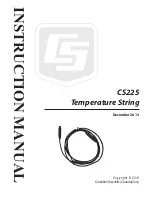
Fridgewatch 2100 Controller Mk4
Section 3
Publication 3-58
Issue 1.1 : 01/08
Page 25 of 152
5.3.
Basics of Starting and Stopping Compressors
In a multi-compressor application where Fridgewatch 2100 automatically
controls the operation of two or three compressors, the first compressor
in the selected running order must load to maximum before Fridgewatch
2100 starts the next available compressor in the running order. Capacity
modulation now transfers to this compressor while the first to start is held
at maximum load. Obviously, when controlling three compressors,
Fridgewatch 2100 loads the first and second compressors in the running
order to maximum before starting the third.
The next compressor to start initially runs at minimum load, this is 25 %
of full load capacity for HallScrew 2100, 3100, 3200 or 4200 series
compressors or 10 % of full load capacity for HallScrew 2000 series
compressors. It is possible to compensate for this sudden increase in
compressor capacity, using operator setting S11 Enable Unload off
Maximum on Starting Next Compressor to unload the compressor at
maximum load by a small amount. The compressor which was unloaded
off maximum load now takes priority for loading until it is once again
running at maximum load, after which capacity modulation reverts to the
last compressor to start. S11 is not implemented if the next compressor
was started because a limiting input, for example, current limiting,
prevented the previous compressor from loading.
On falling demand for duty, Fridgewatch 2100 permits the modulated
compressor to unload to minimum before stopping it and transferring
capacity modulation to the compressor previously held at maximum.
In the case of three compressors, if the second compressor in the
running order should fail to start for some reason, Fridgewatch 2100
automatically starts the third compressor; at the same time the
TRIP
indicator ‘flashes’ to draw the operator’s attention to the fault condition.
This method of control, though simple in principle, hides a far more
sophisticated and flexible control scheme.
5.4. Set
Point
Deviation
A feature of the Fridgewatch 2100 control concept, for multi-compressor
applications, relates to starting another compressor when the demand
exceeds the capacity of the compressor(s) already in operation.
To minimise power consumption it is essential to avoid starting another
compressor until absolutely necessary and not to have it running longer
than necessary. Using conventional relay based controls, it is all too
easy to start another compressor when, for example, there is a temporary
increase in load, the duty requirement being only slightly greater than the
compressor(s) already running can provide.
Unnecessary cycling of compressors is prevented to a certain extent by
inserting a timer, S8 Next Compressor Start Delay, between the
modulating compressor loading to maximum capacity and starting the
next compressor. If the modulating compressor comes off maximum load
before S8 expires, the delay timer resets and prevents an unnecessary
start. This is the conventional solution to the problem of short cycling but
there are two limitations.
















































